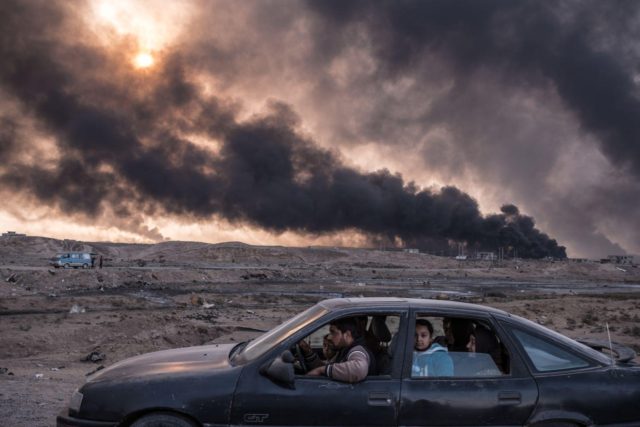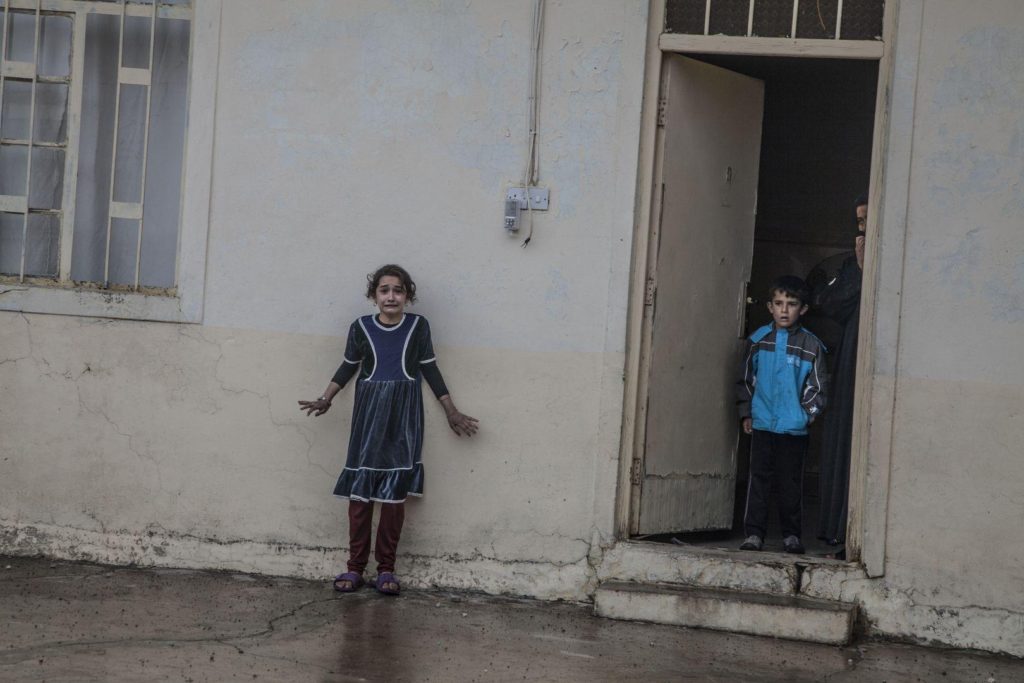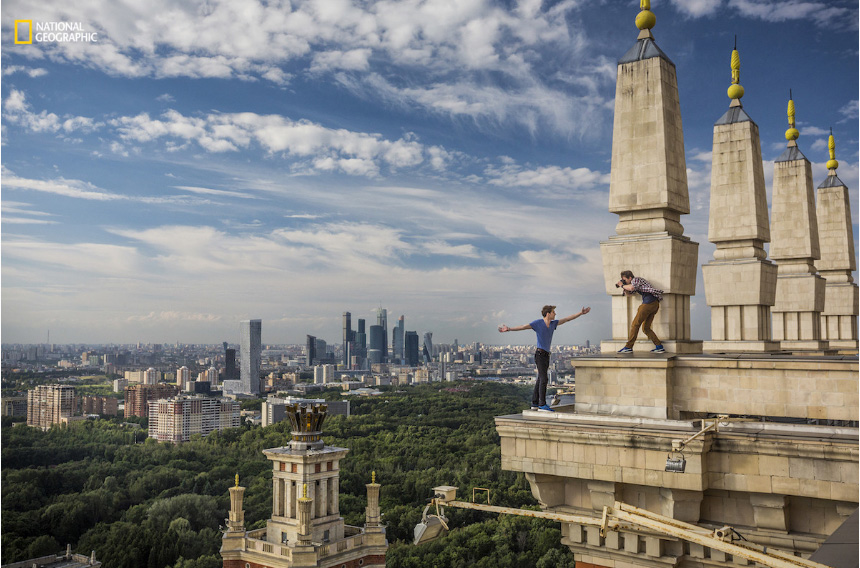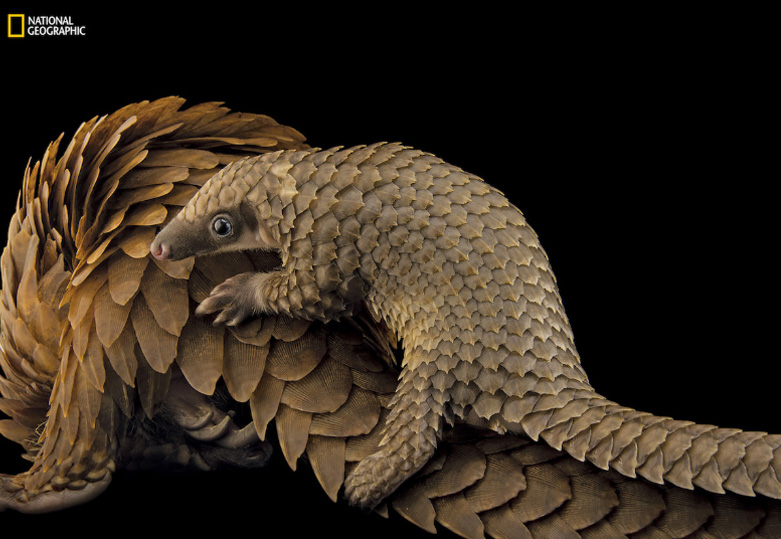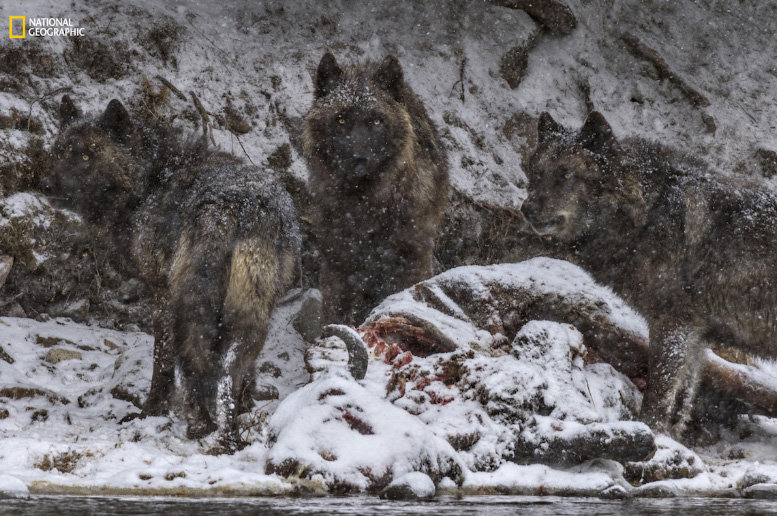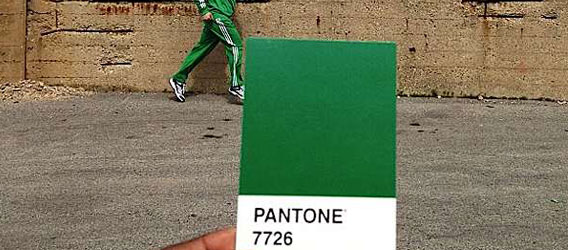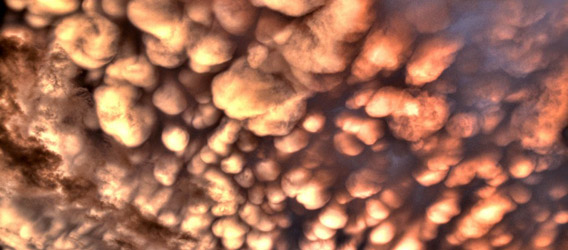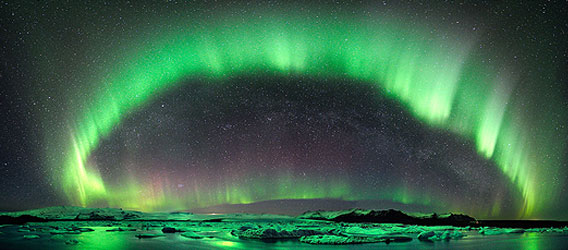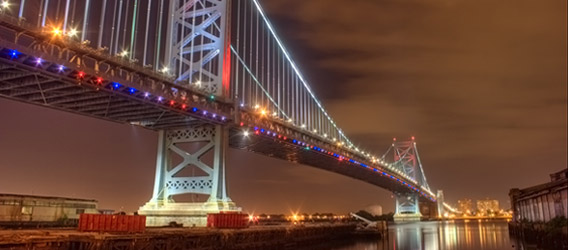1. Lenticular cloud, Mt. Fuji, Japan
Lenticularis Altocumulus es uno de los tipos obviamente más 'bizarros' de nube - no ocurren con mucha frecuencia, así que cuando usted ve una, tomar nota. A menudo se forman montañas sobre o cerca, como el aire húmedo fluye rápidamente en un aumento de la altitud. Monte Fuji es una base muy dulce para éste.

Source unknown
2. Mammatus clouds, Ft. Worth, TX
Another rare and easily recognizable variety, mammatocumulus tend to spill out from the base of massive thunderheads in a characteristic blanket of pouch-like nodules. Generally a good cue to head indoors.

Photo: Lars Plougmann
3. Asperatus formation, Canterbury, New Zealand
This one’s so rare it doesn’t even have official classification. “Undulatus asperatus” is its proposed designation, and if accepted as a new form by meteorologists, it’ll be the first such addition since 1951. As of now, it’s just another example of New Zealand having the coolest freakin’ landscapes.

Photo: wittap
4. Roll cloud hang glider, Queensland, Australia
A variety of arcus cloud, tube-shaped rollers are completely detached from the cloud bodies around them and appear to roll as they move low across the sky. Here, Red Bull athlete Jonny Durand hang glides Queensland’s “Morning Glory.”

Photo: Mark Watson
5. Mammatus over Quebec
Some intense mammatus action precedes the storm over this suburb of Montreal.

Photo: Michel Filion
6. Shelf cloud, North Dakota
Shelf clouds are similar to roll clouds, only they remain attached to their parent cloud formation. Typically, as below, they are harbingers of serious thunderstorms.

Photo: Michael Carlson – Photography
7. Nacreous clouds, McMurdo Station, Antarctica
Some of the highest and rarest clouds on Earth, nacreous clouds form 10+ miles up during winter over polar locations like Antarctica. They are thought to exacerbate the effects of human-caused ozone depletion by producing chlorine, which destroys ozone.

Photo: Alan R. Light
8. Lenticulars, Mt. Rainier, Washington
These are classic lenticular shapes, often referred to as “UFOs.” Going by my Flickr search, they’re somewhat more common than average around Rainier.

Photo: Tim Thompson
9. Cumulonimbus, Nelson, BC
From Matador managing editor Carlo Alcos, friend of the photog: “Taken July 11, 2012 in Nelson. Heavy rain and thunderstorms this summer have caused rivers and lakes to rise to levels not seen in several decades. Numerous evacuation alerts have been issued and a landslide in nearby Johnsons Landing wiped out homes and the only road access to the community. Four people have been missing since, two of them recovered from the debris. Another man died on June 23 in the Slocan Valley when he was swept away by flood waters from a bridge he was standing on.”

Photo: Robert Neufeld
10. Lenticular UFO, Patagonia
Another iconic UFO lenticular cloud, this one spotted over the mountains of Argentinean Patagonia.

Source unknown
11. Shelf cloud, Cape Cod, MA
Not a great day at the beach when you see this rolling your way. This shot was taken over Race Point in June, 2012.

Photo: Anthony Quintano
12. Altocumulus from the ISS
Altocumulus formations usually comprise many individual cloudlets and take shape at heights of 6,500 to 23,000 feet. The whorls visible in this altocumulus layer, as seen from the International Space Station, are caused by two regions of ocean air moving at different speeds.

Photo: Cosmonaut Fyodor Yurchikhin and the Russian Space Agency Press Services
13. Mammatus, Manhattan
When caught in dusk light, any cloud becomes more dramatic — particularly a rare formation like this mammatus, photographed above New York City in 2009.

Photo: Skellig2008
14. Noctilucent clouds over the Tibetan Plateau
Sometimes a little water vapor makes it 50 miles up into the mesospheric layer of the atmosphere and freezes to create noctilucent clouds. Again, the ISS provides a unique perspective from which to photograph these super rare formations, illuminated by an obscured sun.

Photo: NASA Goddard Photo and Video
15. Morning glories, Queensland, Australia
Another iteration of Australia’s famous Morning Glory, this time with multiple roll clouds. The area around Burketown is known for the phenomenon, most likely to appear between September and mid-November.

Photo: Mick Petroff
16. Lenticular funnel, Palm Springs, CA
This fat lenticular cloud took shape over Southern California in April of 2010. It was described by the photographer as feeling “like it was alive.”

Photo: °Florian
17. Fog bow, Sydney, Australia
A similar phenomenon to a rainbow, the fog bow features much smaller droplets of moisture and because of this lacks all but faint color. Usually they appear white, as in this shot taken outside Sydney.

Photo: Nina Matthews Photography
18. Shelf cloud, Wagga Wagga, Australia
It’s pretty obvious from the photo below that shelf clouds are associated with thunderstorm outflow. Get ready.

Photo: Bidgee
19. Waterspout, Balearic Islands, Spain
A waterspout is basically a tornado that’s not associated with a supercell and occurs over water. Coincidentally, the Balearics are also where you can find some of the clearest water in the world.

Photo: Vvillamon
20. Mammatus storm, Norman, OK
Some intense mammatocumulus showing they are indeed tied to storm activity. The photographer notes this was taken with a 1-second shutter speed.

Photo: Angelyn Hobson
21. Altocumulus, Layton, NJ
There’s a lot of diversity in the altocumulus family. Lenticulars belong to the category, and you can see a few faint ones in this shot.

Photo: Nicholas_T
22. Mammatus, Salem, OR
The photographer has labelled these as mammatus clouds, though I’m not that’s what’s going on. Can anyone confirm / refute?

Photo: happy1nva
23. Lenticular arcs, Seattle
Even within a subcategory such as “lenticular,” you get variety. Compare these formations to the mountaintop UFOs above.

Photo: brucedene
24. Roll cloud, Punta del Este, Uruguay
In January of 2009, this roll cloud was seen over the beach resort town of Punta del Este. Roll clouds most often appear in coastal areas — the circulation of sea winds plays a part in their creation.

Photo: Daniela Mirner Eberl
25. “God in the Clouds,” Mt. Baker, Washington
The quote comes from the photographer, who picked out some distinct facial features in this formation over Mt. Baker in northern Washington in August of 2008.

Photo: Jeff Pang
26. Cloud iridescence, Arizona
Iridescence in clouds is produced by the diffraction of sunlight by small ice crystals. Colors are typically pastel and faint, though on occasion they can become more brilliant, as below.

Photo: benafiaskys
27. Mammatus, Colorado Springs, CO
A 2005 storm over the United States Air Force Academy campus involved some pretty mean looking mammatus clouds.

Photo: markwgallagher
28. Lenticular clouds, France
These lenticulars appear to be composed of multiple oval-shaped layers, and their whipped tails give them a unique look.

Photo: Marc Veraart
29. Shelf cloud, Miami, FL
December 4, 2010, does not seem like it was a good day to be on the ocean or at the beach in Miami.

Photo: kun0me
30. Stratus clouds, Arenal Volcano, Costa Rica
Low-forming stratus clouds are commonly known as fog — also mist, like the stuff enshrouding Costa Rica’s Arenal Volcano in the photo below.

Photo: REDFISH1223
31. Cumulonimbus, Ft. Worth, TX
More powerful storm activity over Ft. Worth. This is a detailed look at part of a massive cumulonimbus formation from May of 2011, which appears to have some supercell updraft potential.

Photo: guruscotty
32. Lenticular ribbon, Tarurua Range, New Zealand
I’m not sure if conditions for crazy lenticular action are riper in New Zealand than elsewhere, but I’d definitely believe it based on this photo collection. The formation below seems like another candidate for the proposed “undulatus asperatus” classification.

Photo: Chris Picking
33. Noctilucent clouds, Viljandimaa, Estonia
Here’s another example of the highest-forming cloud type (as much as 50 miles up in the atmosphere). In the foreground is Kuresoo bog, in southern Estonia, which provides a pretty amazing reflection scenario.

Photo: Martin Koitmäe
34. Wall cloud, Kansas
If I were this lady, I’d put the camera down and book it for shelter.

Photo: Pe Tor
35. Glories and vortices, Baja
The intended subjects of this NASA satellite image are the very faint north-south-running lines of color, known as “glories,” visible to the west of Guadalupe Island. I included it here because I like the more apparent von karman vortices, the swirls trailing off to the island’s south.

Photo: NASA Goddard Photo and Video
36. Mammatus, Brooklyn Park, MN
Looking at these mammatus pictures never gets old for me, maybe because I don’t think I’ve ever seen any in person.

Photo: McAli333
37. Lenticular ribbon, Las Vegas, NV
This one is similar to the formation from New Zealand a couple shots up, minus the sunset colors. I guess cloud photography is something to do in Vegas besides gamble.

Photo: rappensuncle
38. Kelvin–Helmholtz instability clouds, Seattle
These clouds are the visible manifestation of an otherwise invisible process; Wikipedia explains: “The Kelvin–Helmholtz instability (after Lord Kelvin and Hermann von Helmholtz) can occur when there is velocity shear in a single continuous fluid, or where there is a velocity difference across the interface between two fluids.”

Photo: Clint Tseng
39. HDR Mammatus, NYC
Somehow fitting that this shot was taken in Hells Kitchen.

Photo: CMMooney
40. Pileus cloud, Chitlapakkam, India
Referred to as a “cloud accessory,” pileus formations are extremely short-lived. They form in similar fashion to lenticulars, only over clouds in place of mountains. As shown below, they’re thin enough to pick up some color from the setting sun.

Photo: vishwaant
41. Arcus layers, Australia
A nicely captured lightning strike provides some backlighting for these arcus clouds, which probably signal the arrival of a storm front.

Photo: ~Bootscrub
42. Fallstreak hole, Linz, Austria
Also known as hole punch clouds, these formations occur as the moisture in a layer of cirrocumulus or altocumulus starts to freeze and fall to earth. Alternatively, they may signify an isolated pocket of evaporation.

Photo: H. Raab
43. Lenticular UFO, Kananaskis Country, Alberta
A perfect UFO cloud formed in July of 2008 over the Kananaskis, a section of the Canadian Rockies in Alberta.

Photo: sabertasche2
44. Wave clouds, Tadrart region, Algeria
As air travels over a raised land feature, it sometimes forms an atmospheric wave on the opposite side of the feature. Air then essentially surfs the wave, and when moisture conditions are right, these characteristic cloud bands are the result.

Photo: Wikimedia Commons
45. Shelf cloud, Kearney, NE
From the photographer: “I was out Weather Spotting for Buffalo County…. Just a beautiful shelf cloud and perfect conditions for this storm. Had to drive like a banshee to get back in front of the storm once it got too close. By far my best of 2009.”

Photo: NebraskaSC
46. Wall cloud, South Dakota
Wall clouds form beneath the underside of cumulonimbus clouds, typically within the zone where rain is not produced. Wall clouds that demonstrate rotation could indicate that a massive tornado is imminent.

Photo: Michael Carlson – Photography
47. Cirrocumulus cloud, Chilbridge, England
Made up of tiny ice crystals, cirrocumulus are high-forming clouds and are usually fleeting. I included this shot because it reminds me of ripples on water.

Photo: .FuturePresent.
48. Cumulonimbus, Beverley, England
This one certainly has the look of a violent supercell storm, but it’s hard to tell from this distance — what makes the difference is whether there’s a persistent rotating updraft within the formation.

Photo: l.bailey_beverley
49. Lenticular roll cloud?, Lake Tahoe, NV
It seems to combine features of both, running a crazy ribbon down the sky.

Photo: eglavin
50. Arcus clouds, Wellington, New Zealand
More giant arcus layers, this time catching some color from sunset.

Photo: PhillipC
51. Mammatus, Saylorsburg, PA
Mammatus clouds tagged along with a thunderstorm in eastern Pennsylvania, March of 2009. I love how smudgy they look in contrast to the fractal sharpness of the trees.

Photo: Nicholas_T
52. Cirrostratus nebulosus, Santa Catarina, Brazil
This species of cirrostratus cloud is so light it’s often invisible unless illuminated from a certain angle by the sun, which produces a halo effect.

Photo: emarquetti
53. Cloud iridescence
The best specimens of cloud iridescence occur in clouds that are optically thin, with the light hitting individual droplets of moisture.

Photo: Brocken Inaglory
54. Lenticular clouds, France
A gathering of lenticular UFOs over the French countryside.

Photo: Marc Veraart
55. “The Cloud of Darkness,” Silver City, NM
This is the name the photographer gave to the massive thunderhead pictured below, which formed over southwestern New Mexico in August of 2007.

Photo: deansouglass
56. Lenticular blanket, Lebanon, MO
From the photographer: “I took this in 2002 in Lebanon, Missouri. I saw the clouds roll in and knew I had a few minute window to get a possible picture. I high tailed it from my place (about 3/4 mile) to get a nice view.”

Photo: thefixer
57. Wave cloud, Amsterdam Island
This is an awesome perspective on the wave cloud phenomenon, captured by a NASA satellite above the far southern Indian Ocean.

Photo: Wikimedia Commons
58. Cumulonimbus, Melbourne, Australia
This hefty storm cloud appeared over Melbourne in July of 2007.

Photo: Gideon Tsang
59. Shelf cloud, Hampton, MN
A ragged shelf cloud portends an ominous few hours for this little suburb in Minnesota.

Photo: chief_huddleston
60. Vortex cloud, Wallops Island, VA
The photo below is from a NASA study on the wake vortices of aircraft. Here, the vortex phenomenon is made observable with the use of colored smoke. The formation occurs naturally in many diverse scenarios — tornadoes, hurricanes, and cyclones being obvious cloud-related examples.

Photo: NASA Langley Research Center (NASA-LaRC)
Artículo Original aquí


